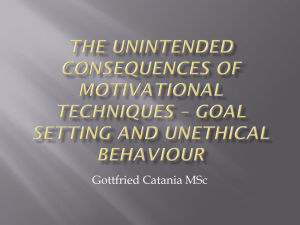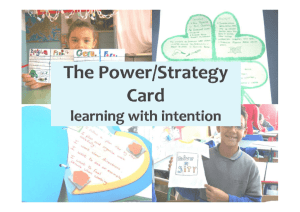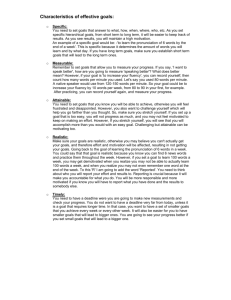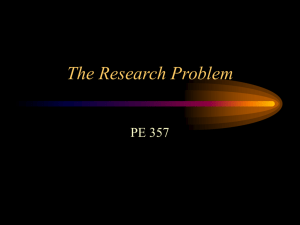Spring 2004, Vol. 2 No. 2 STATISTICS
advertisement
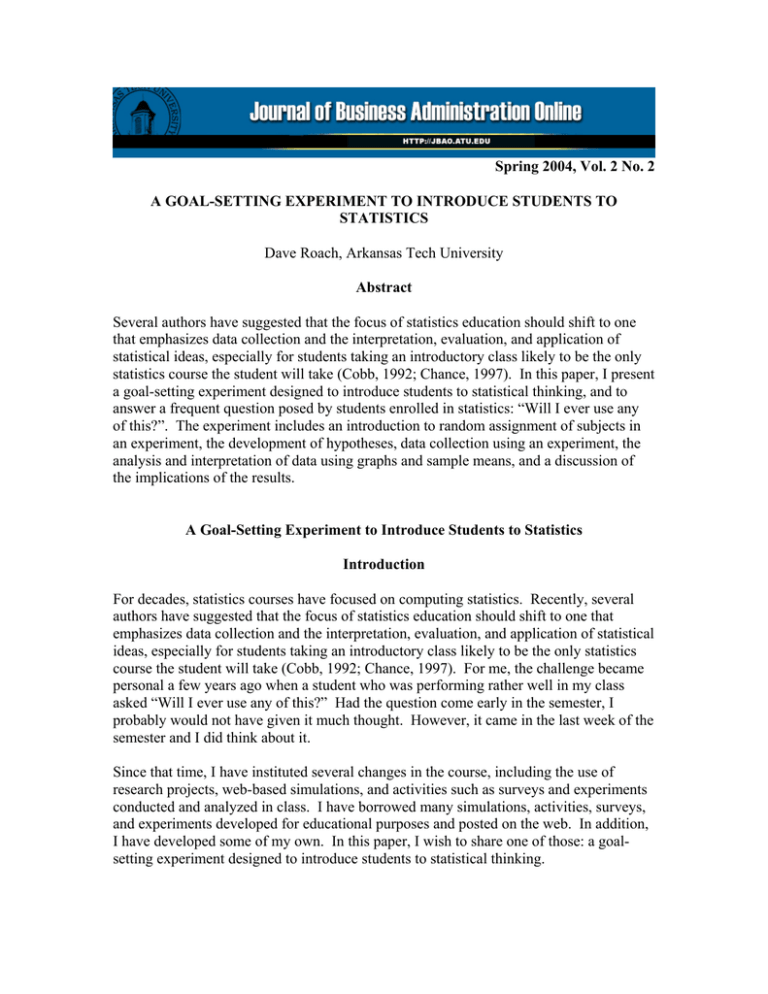
Spring 2004, Vol. 2 No. 2 A GOAL-SETTING EXPERIMENT TO INTRODUCE STUDENTS TO STATISTICS Dave Roach, Arkansas Tech University Abstract Several authors have suggested that the focus of statistics education should shift to one that emphasizes data collection and the interpretation, evaluation, and application of statistical ideas, especially for students taking an introductory class likely to be the only statistics course the student will take (Cobb, 1992; Chance, 1997). In this paper, I present a goal-setting experiment designed to introduce students to statistical thinking, and to answer a frequent question posed by students enrolled in statistics: “Will I ever use any of this?”. The experiment includes an introduction to random assignment of subjects in an experiment, the development of hypotheses, data collection using an experiment, the analysis and interpretation of data using graphs and sample means, and a discussion of the implications of the results. A Goal-Setting Experiment to Introduce Students to Statistics Introduction For decades, statistics courses have focused on computing statistics. Recently, several authors have suggested that the focus of statistics education should shift to one that emphasizes data collection and the interpretation, evaluation, and application of statistical ideas, especially for students taking an introductory class likely to be the only statistics course the student will take (Cobb, 1992; Chance, 1997). For me, the challenge became personal a few years ago when a student who was performing rather well in my class asked “Will I ever use any of this?” Had the question come early in the semester, I probably would not have given it much thought. However, it came in the last week of the semester and I did think about it. Since that time, I have instituted several changes in the course, including the use of research projects, web-based simulations, and activities such as surveys and experiments conducted and analyzed in class. I have borrowed many simulations, activities, surveys, and experiments developed for educational purposes and posted on the web. In addition, I have developed some of my own. In this paper, I wish to share one of those: a goalsetting experiment designed to introduce students to statistical thinking. Goal-Setting Experiment Purpose of the activity The overall purpose of the activity is to introduce students to the basics of data collection and analysis for an experiment. The specific concepts introduced are random assignment, the development of hypotheses, performing an experiment to collect data, testing hypotheses, and interpreting results. I conduct the experiment on the first or second day of the semester. Random Assignment On the first day of class, shortly after students are seated, I ask if any students have a TI83, the calculator required for prerequisite math classes. In the event no one has a calculator, I have a couple with me. Using an n equal to the number of students in the class, a selected student uses the random integer math function to generate numbers. Though they will obtain different values, students with calculators are encouraged to follow along. Using the class roster as a sampling frame, I assign each assign student in the class to one of three groups as each number is announced. It might be easier to use an n of 3 on the calculator and simply move down the roster, but student reaction to hearing their “number” called seems to elicit a stronger sense of anticipation. Conducting the experiment Once students are assigned to groups, I ask groups B and C to leave and wait outside the classroom. Once those students have left, I ask the students in Group A to take out a sheet of paper and a pencil or pen. Then, I display the following statement on a PowerPoint slide: Please list as many ideas as you can to improve our university over the next five to ten years. I suggest that students keep the items on the list to one to five words, and then announce that they have five minutes to complete the task. After four minutes, I announce that they have one minute remaining to complete the task. After the time is expired, I ask students to count the number of ideas listed and write that number on the top of the page. I also ask them to write the letter A at the top of the page. I ask group A to stay in the room and I ask group B to return to the room. The procedure is repeated for group B with two exceptions. First, I ask students to number their paper from one to ten before the question is displayed. Second, the question on the PowerPoint slide is now: Please list ten ideas to improve our university over the next five to ten years. After group B completes the task, I ask group C to return. I ask them to number their papers from one to twenty and present them with the following question: Please list ten ideas to improve our university over the next five to ten years. Theory and Hypotheses In this portion of the activity, I stress two points. First, hypotheses should be based on some theory, logic, or previous (and perhaps serendipitous) observation. Second, hypotheses should be computed before the data are collected. I then briefly describe the theory and logic for two hypotheses that can be tested with the data from the experiment. The first hypothesis is based on portions of Locke and Latham’s (1990) goal setting theory, according to which specific and challenging but attainable goals lead to higher performance than vague goals. Locke and Latham (1990) suggest that specific goals lead to higher performance because they provide an exact target for the individual. Locke and Latham (1990) also argue that goals should be challenging, higher than the performance level that would be achieved in the absence of specific goals) yet attainable. I then indicate that the “list as many …” instructions were designed to be vague and that in previous semesters students who had been presented with these instructions usually listed an average of six or seven items. By contrast, I note that the “list 10 ideas” instructions presents a specific and challenging but attainable goal. In contrast, other authors (Hargrove, nd; Sutton, 2004) argue that individuals perform best when “stretched” by extremely challenging goals. The idea of stretch goals is embodied in the use of six-sigma management, a method used in many businesses (Vierling-Huang, 1999). In essence, six-sigma suggests that the occurrence of defective products or services should never (or almost never) occur. This stands in stark contrast to past management models that simply tried to estimate and “cover” the costs of poor quality (product replacement, repair costs, etc.). Based on these two competing theories, two hypotheses are put forth. Hypothesis 1: Students presented with specific and challenging but attainable goals will list more items than students with either vague or stretch goals. Hypothesis 2: Students presented with stretch goals will list more items than students with either vague or specific and challenging but attainable goals. Analysis of results While I tabulate and compute the results, students discuss the three examples in the appendix. Before the students discuss the examples, I briefly explain sample means and dot plots. Students discuss the examples in small groups for about ten minutes. I then ask students to explain the examples. I then lead a class discussion based on the results I computed while they were discussing the examples. Other concepts addressed in the activity Time permitting, other issues that can be addressed include: • Dependent (or response) variables versus independent (predictor) variables • Quantitative versus qualitative variables • Descriptive versus inferential statistics • Ways to conceptualize the spread in the data Summary What do we want students to remember about a first course in statistics? What do students remember about a first course statistics? For years, the focus of statistics courses has been computation. That may be what we wanted students to remember about the class, but based on my conversations with other teachers and with students who had successfully completed the class in previous semesters, very few do. For many, the focus is shifting to statistical literacy and statistical thinking where data is collected, analyzed with an emphasis on graphs and other visualizations, and then interpreted and evaluated. Statistical ideas, not statistical computations that can be obtained from a computer package or handheld calculator, are stressed. In this paper, I presented an activity that included an introduction to random assignment of subjects in an experiment, the development of hypothesis, data collection using an experiment, the analysis and interpretation of data using graphs and sample means, and a discussion of the implications of the results. Though I use this experiment on the first day of class, it could also be used later in the semester to introduce one way analysis of variance. Bibliography Chance, B.L. (1997). Experiences with authentic assessment techniques in an introductory statistics class. Journal of Statistics Education v.5, n.3. Cobb, G. (1992), "Teaching Statistics," in Heeding the Call for Change: Suggestions for Curricular Action, ed. L. Steen. MAA Notes, No. 22, Washington: Mathematical Association of America, pp. 3-34. Hargrove, R. (nd). 4 principles for setting stretch goals. Retrieved from WWW on April 19, 2004. http://www.smartbiz.com/article/view/301/1/3/ Locke, E.A. & Latham, G.P. (1990). A theory of goal setting and task performance. Englewood Cliffs, NJ: Prentice Hall. Sutton, P. (2004). What are stretch goals? Retrieved from WWW on April 19, 2004. http://www.green-innovations.asn.au/what-are-stretch-goals.rtf Vierling-Huang, J. (1999). in The dance of change by P.M. Senge, A. Kleiner, C. Roberts, & R. Ross. New York: Doubleday. Appendix Example One C CC C AA AA A C B A C B BBBB +--+--+--+--+--+--+--+--+--+--+--+--+--+--+--+--+--+--+--+-1 2 3 4 5 6 7 8 9 10 11 12 13 14 15 16 17 18 19 20 For example one, many students, with some prodding, readily see and conclude that group B, the group that received the specific and challenging but attainable goals, listed more ideas, on average, than did other groups. They almost always comment that (a) that there are differences within each group and (b) the sample size may not be large enough to arrive at general conclusions. When asked to discuss the implications of these results, students recognize that the data suggest that goals should be specific and challenging but attainable. Example Two AA C BB B BBB AA A A C C C CC +--+--+--+--+--+--+--+--+--+--+--+--+--+--+--+--+--+--+--+-1 2 3 4 5 6 7 8 9 10 11 12 13 14 15 16 17 18 19 20 In example two, many students are able to easily conceptualize the results and implications. Again, the issues of differences within each group and sample size often arise. Example 3 CC BB B BBB AA AA A A C C CC +--+--+--+--+--+--+--+--+--+--+--+--+--+--+--+--+--+--+--+-1 2 3 4 5 6 7 8 9 10 11 12 13 14 15 16 17 18 19 20 Many students find example three to be more difficult to comprehend, at least initially. Many look at the sample means and immediately conclude that stretch goals lead to higher performance. After a couple of minutes of reflection (sometimes at my suggestion), many students see that the large variation in group C may lead one to reconsider their initial conclusion.




